Sony 1222101 Licensed Transmitter User Manual T106
Sony Mobile Communications Inc Licensed Transmitter T106
Sony >
Exhibit 8 User Manual
This is the Internet version of the user's guide. © Print only for private use.
3
Contents
Quick guide 5
Easy access to certain functions.
Getting started 8
Make and receive the first call.
Getting to know your phone 11
Key functions, quick keys, entering letters.
Personalizing your phone 18
Choose ring signal, create pictures and more.
Calling 27
Use the phone book, call options.
Messaging 43
E-mail and text messages.
Using mobile Internet 48
WAP browser, bookmarks.
More features 52
Calendar, alarm clock, games and more.
Security 55
SIM card lock, phone lock.
Troubleshooting 57
Why doesn’t the phone work the way I want?
Additional information 60
Safe and efficient use, warranty, declaration of conformity
Display icons 69
What do the icons mean?
Index 71
This is the Internet version of the user's guide. © Print only for private use.
4
Sony Ericsson T106
GSM 850/GSM 1900
First edition (December 2002)
This manual is published by Sony Ericsson Mobile
Communications AB, without any warranty.
Improvements and changes to this manual
necessitated by typographical errors, inaccuracies of
current information, or improvements to programs
and/or equipment, may be made by Sony Ericsson
Mobile Communications AB at any time and without
notice. Such changes will, however, be incorporated
into new editions of this manual.
All rights reserved.
©Sony Ericsson Mobile Communications AB,
2002
Publication number: AE/LZT 108 6344/2 R1A
INNOVATRON PATENTS
Please note:
Some of the services in this manual are not supported
by all networks. This also applies to the GSM
International Emergency Number 112.
Please contact your network operator or service
provider if you are in doubt whether you can use a
particular service or not.
Please read the Guidelines for safe and efficient use
and the Limited warranty chapters before you use
your mobile phone.
T9™ Text Input is a registered trademark of Tegic
Communications.
T9™ Text Input is licensed under one or more of the
following: U.S. Pat. Nos. 5,818,437, 5,953,541,
5,187,480, 5,945,928, and 6,011,554; Canadian Pat.
No. 1,331,057, United Kingdom Pat. No. 2238414B;
Hong Kong Standard Pat. No. HK0940329; Republic
of Singapore Pat. No. 51383; Euro.Pat. No. 0 842
463(96927260.8) DE/DK, FI, FR, IT, NL, PT, ES, SE,
GB; and additional patents are pending worldwide.
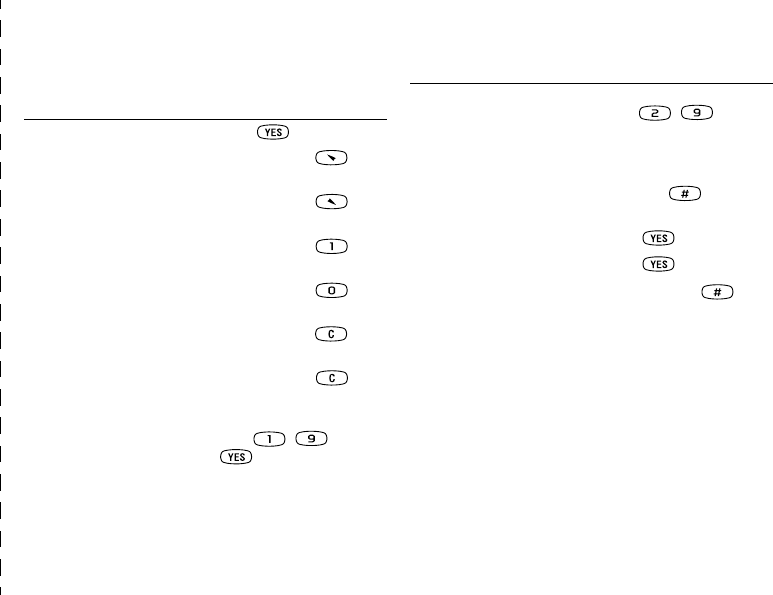
This is the Internet version of the user's guide. © Print only for private use.
Quick guide 5
Quick guide
To... Do this:
enter the Call List press from standby
to enter the first function in
the menu My Shortcuts
press and hold from
standby
to enter the Find and Call
menu
press and hold from
standby
Call your voice mail service press and hold from
standby
enter the + sign to make an
international phone call
press and hold from
standby
set the phone to silent press and hold from
standby
turn off the microphone press and hold
during a call
speed dial (phone book
positions 1–9)
press any of the number
keys – and
from standby
find a phone book entry
beginning with the first letter
(or the closest following) on a
key
press and hold any of the
keys – from
standby
find a phone book entry enter the position number
and press from
standby
put a call on hold press
switch between two calls press
enter the Options menu when
writing a text message
press and hold
To... Do this:
This is the Internet version of the user's guide. © Print only for private use.
6 Quick guide
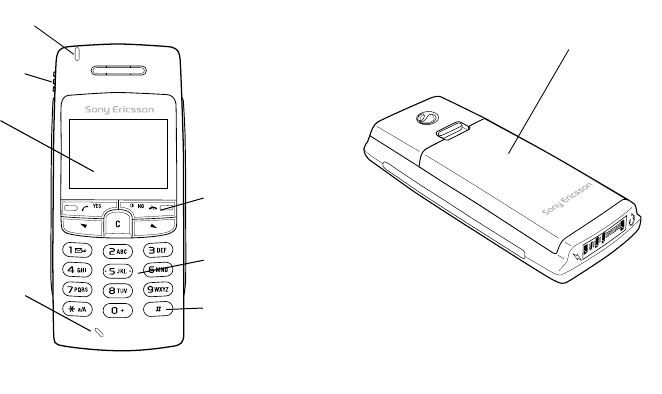
This is the Internet version of the user's guide. © Print only for private use.
7
Front Back
Indicator light
Volume key
Display
Microphone
On/off key
Keypad
Option key
Back cover

This is the Internet version of the user's guide. © Print only for private use.
8 Getting started
Getting started
About this User’s Guide
Some services and functions described in this User’s
Guide are network- and subscription-dependent.
Because of this, all menus may not be available in your
phone and the shortcut numbers to menus and
functions may vary between phones.
This symbol indicates that a service or
function is network- or operator-dependent.
Please refer to the information provided by
your network operator for more information
about your subscription.
We recommend that you read the chapter “Getting
to know your phone” on page 11 for information about
how to move through the menus.
The SIM card
When you register as a subscriber with a network
operator, you get a SIM (Subscriber Identity Module)
card. The SIM card contains a computer chip that
keeps track of your phone number, the services
included in your subscription, and your Phone Book
information, among other things.
Assembly
Before you can use your phone you need to:
• insert the SIM card.
• attach and charge the battery.
Note: Always turn off the phone and detach the
charger before you insert or remove a SIM card.
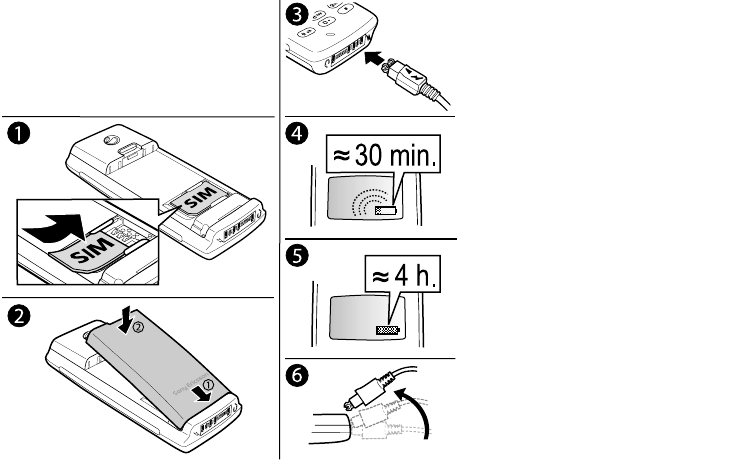
This is the Internet version of the user's guide. © Print only for private use.
Getting started 9
SIM card and battery information
It may take up to 30 minutes before an
icon appears in the display when
charging.
1. Insert the SIM card. Make sure the SIM
card is placed under the silvery holders.
2. Place the battery on the back of the phone
and push until you hear a click.
3. Connect the charger to the phone at the
flash symbol. The flash symbol on the
charger plug must face upwards.
4. It can take up to 30 minutes before an
icon is shown in the display.
5. Wait approximately four hours or until
you see the battery is fully charged.
6. Remove the charger by tilting the plug
upwards.
You have to insert the SIM card and
charge the battery before you can use
the phone.
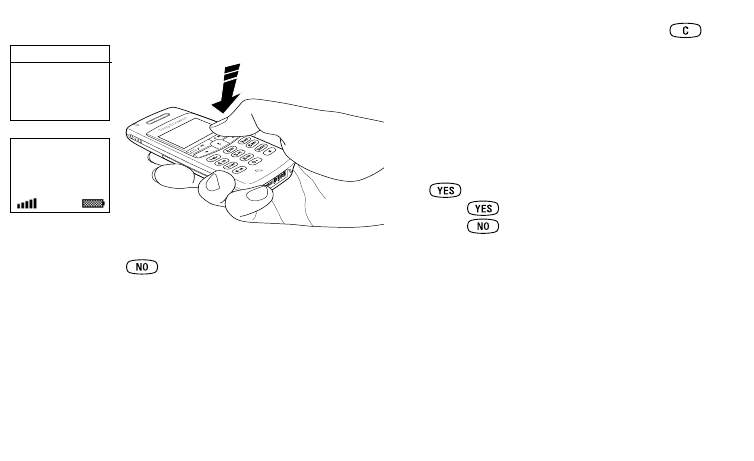
This is the Internet version of the user's guide. © Print only for private use.
10 Getting started
Making and receiving calls
To turn on the phone
• Press and hold until you hear a tone.
• Enter your PIN (Personal Identity Number), if you
have one for your SIM card.
Your PIN is provided by your network operator.
On/off
My Network
12:18
SIM locked
PIN:
If you make a mistake while entering your PIN,
delete the wrong number by pressing .
If you enter your PIN incorrectly three times in a
row, the SIM card is blocked. This is indicated by
the message PIN blocked. To unblock it you need
to enter your PUK (Personal Unblocking Key).
Your PUK is provided by your network operator.
To make and receive calls
• Enter the area code and phone number and press
.to make a call.
• Press to answer a call.
• Press to end a call.
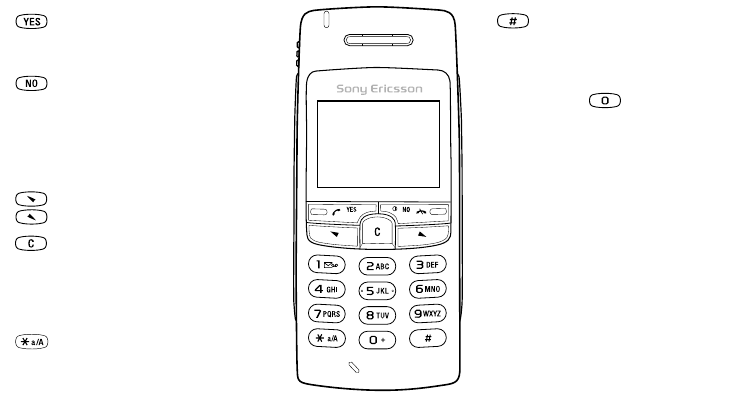
This is the Internet version of the user's guide. © Print only for private use.
Getting to know your phone 11
Getting to know your phone
Key functions
Make and answer calls.
Select a menu, submenu or
an option.
Press and hold to turn the
phone on or off or to go back
to standby mode. Press to
end or reject a call, go back
one level in the menus, or
leave an option unchanged.
Move through the menus,
lists and text.
(clear)
Delete numbers and letters
from the display. Delete an
item from a list. To turn off
the microphone during a
call, press and hold the key.
Enter *.
Enter #. Press and hold to
enter the Option menu.
1–9, 0 Enter the digits 0–9 and
letters. Press and hold
to enter the
international prefix +.
Move through menus
using shortcuts.
Volume key Increase or decrease the
volume of the earpiece
during a call. Scroll
through menus, lists and
text. Enter the Status
menu. To reject an
incoming call, slide the
key up or down twice.
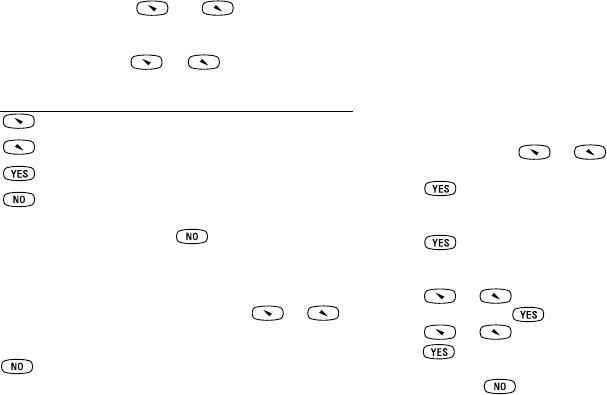
This is the Internet version of the user's guide. © Print only for private use.
12 Getting to know your phone
Moving through the menus
There are two ways of moving through the menus:
• Scrolling with the and keys
• Using shortcuts
Scrolling by using or
Using shortcuts
A quicker way to move through the menus is to use
shortcuts. Enter the menus by pressing or
and then simply enter the number of the menu to which
you want to go. To get back to standby, press and hold
.
How to interpret the instructions
In this example of how to interpret the instructions, we
are going to set the key sound to the tone option.
To set the key sound
1. Scroll to Settings, YES, Sounds & Alerts, YES, Key
Sound, YES.
2. Select Tone and press YES.
Interpret the instructions as follows:
1. From standby, press or to scroll to the
Settings menu.
2. Press to select the Settings menu. The name of
the menu that you have chosen is shown at the top of
the display Settings.
3. Press to select the Sounds & Alerts submenu.
(You do not need to scroll with the arrow keys as this is
the first submenu).
4. Press or to scroll to the Key Sound
submenu and press to select it.
5. Press or to scroll to the Tone option and
press to select it. You have now set the key sound
to tones.
6. Press and hold to go back to standby.
Press... to...
scroll left or up through the menus.
scroll right or down through the menus.
select a menu, submenu or an option.
go back one level in the menus or leave an
option unchanged.
press and hold to go back to standby.

This is the Internet version of the user's guide. © Print only for private use.
Getting to know your phone 13
Display text
• Text that is highlighted indicates your position in the
menu. If you press , you enter this menu or select
this option.
• Grey text indicates a function that is temporarily
unavailable, for example, due to your subscription or
due to a certain setting which has not been turned on.

This is the Internet version of the user's guide. © Print only for private use.
14 Getting to know your phone
Menu overview
My Network
12:18
Find and Call
Add Number
Find and Edit
CLI Pictures
Personal Rings
Groups
Email Addresses
Options
Memory Status
Special Numbers
Call Voicemail
Inbox
Write New
Unsent
Templates
Sent Items
Options
Missed Calls
Call List
Call Costs
Call Timers
Next Call
Options
Turn Off Tones*
Hold Call*
Switch Calls*
Release Active*
Join Calls*
Transfer Call*
Release All*
Sounds & Alerts
Profiles
Call Options
Networks
Display
Language
Time and Date
Locks
Handsfree
Phone Name
Master Reset
Calendar
Time
Pictures
Stopwatch
Calculator
Games
Homepage
Bookmarks
Push Inbox
Enter Address
Resume
Select Profile
Clear Cache
WAP Settings
Write New
Pictures
Ring Volume
Edit Shortcuts
Please note that some menus are
network- and subscription-dependent.
* Only available during a call.
Phone book Messages Call info Settings Extras WAP services My shortcuts

This is the Internet version of the user's guide. © Print only for private use.
Getting to know your phone 15
Entering letters
You can enter letters when you add names to the phone
book, write text messages (SMS) or enter WAP
addresses.
You enter letters in your phone using multitap text
input, which is default, or you can use T9™ Text
Input, if the input language you select supports this.
T9 Text Input is a quicker way to write texts. See
“T9™ Text Input” on page 16.
Input language
Before you start entering letters, you need to select the
input languages you want to use when writing.
To select input language
1. Scroll to Settings, YES, Language, YES, Input, YES.
2. Scroll to the language you want to use for entering
letters and press .
Repeat step 2 if you want to use another language.
3. Press YES to exit the menu.
When writing, you can switch to one of your selected
input languages by pressing and holding .
Multitap text input
When saving names in the phone book or when writing
WAP addresses, you always enter letters using
multitap text input.
In the following example, we are going to write a
text message:
To enter letters using multitap text input
1. Scroll to Messages, YES, Write New, YES.
2. Press the appropriate key, – , or
repeatedly, until the character you want appears in the
display.
Press… to get…
Space - ? ! ‚ . : ; " ’ < = > ( ) _ 1
A B C Å Ä Æ à Ç 2 Γ
D E F è É 3 ∆ Φ
G H I ì 4
J K L 5 Λ
M N O Ñ Ö Ø ò 6
P Q R S ß 7 Π Σ
T U V Ü ù 8
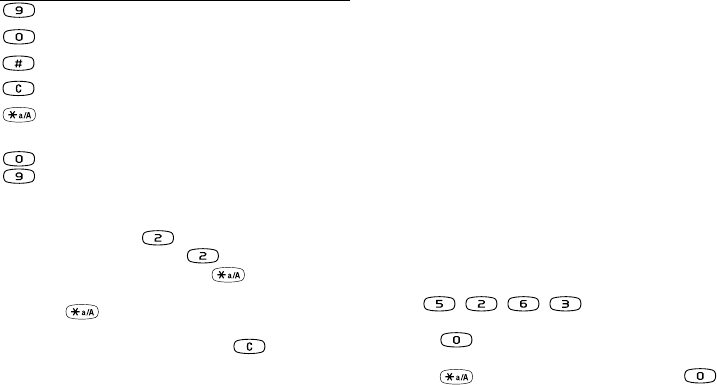
This is the Internet version of the user's guide. © Print only for private use.
16 Getting to know your phone
Example:
• To enter an ‘A’, press once.
• To enter a ‘B’, quickly press twice.
• To enter lower-case letters, press , enter the letter,
for example, an ‘A’. Lower-case letters appear until
you press again.
• To enter numbers, press and hold any numeric key.
• To delete letters and numbers, press .
Note: When your enter letters in a WAP address, some
of the characters show up in a different order.
T9™ Text Input
You can use T9 Text Input when writing texts such as
text messages and e-mail messages. The T9 Text Input
method uses a built-in dictionary to recognize the most
commonly used word for every sequence of key
presses. This way, you press each key only once, even
if the letter you want is not the first letter on the key.
When you press the keys, a word is suggested.
Note: T9 Text Input is not available in all languages.
To turn the T9 Text Input on or off
1. Scroll to Settings, YES, Language, YES, T9 Input, YES.
2. Select On or Off.
To enter letters using T9 Text Input
1. Scroll to Messages, YES, Write New, YES.
2. For example, if you want to write the word “Jane”,
press , , , .
If the word shown is the one you want:
• press to accept the word and add a space.
If the word shown is not the one you want:
• press to view alternative words. Press to
accept the word and add a space.
W X Y Z 9
+ & @ / ¤ % $ £ ¥ § ¿ ¡ 0 Θ Ξ Ψ Ω
# *↵
to delete letters and numbers
to shift between capital and lower-case
letters
– press and hold to enter numbers
Press… to get…

This is the Internet version of the user's guide. © Print only for private use.
Getting to know your phone 17
If you do not find the word you want by pressing
:
• press and hold to switch to basic text input
(abc). Move the cursor by using or and
then delete letters by pressing . Enter letters by
pressing the appropriate key the number of times
needed until you get the letter you want.
3. Continue writing your message. See also “To send a
text message” on page 43.
Key functions when using T9 Text Input
•Input method
Press and hold to switch input method.
•Accept word
Press to accept the suggested word and add a
space.
•Candidates
Press repeatedly to scroll between the suggested
words.
•Symbols
Press repeatedly to scroll between punctuation
marks and add symbols such as ? and ,.
•Digits
Press and hold if you only want to enter digits.
•Rel. caps lock
Press to switch between capital and lower-case
letters.

This is the Internet version of the user's guide. © Print only for private use.
18 Personalizing your phone
Personalizing your phone
You can adjust the phone settings to suit your own
needs.
Ring signals
You can specify the ring signal volume, choose among
different ring signals or compose your own ring
signals.
Ring signal volume
The ring signal volume can be set to six levels. You
can also turn the ring signal off (0).
To set the ring signal volume
1. Scroll to Settings, YES, Sounds & Alerts, YES, Ring
Volume, YES.
2. Press or to increase or decrease the
volume.
3. Press YES to save the setting.
Tip: Use the volume keys on the side of the phone to
change the volume silently.
To turn the ring signal on or off
1. From standby, press and hold .
2. Select Turn On Silent and press YES.
All signals except the alarm and timer signals are
turned off.
To cancel, repeat step 1, select Turn Off Silent and
press YES.
Increasing ring
You can choose a ring signal that rises in steps from
the lowest volume to the highest.
To turn the increasing ring on or off
1. Scroll to Settings, YES, Sounds & Alerts, YES,
Increasing Ring, YES.
2. Select On or Off and press YES.
Ring signal type
You can choose a ring signal from a list of different
sounds and melodies.
To choose a ring signal
1. Scroll to Settings, YES, Sounds & Alerts, YES, Ring
Sounds, YES, All Voice Calls, YES.
2. Select a ring signal and press YES.
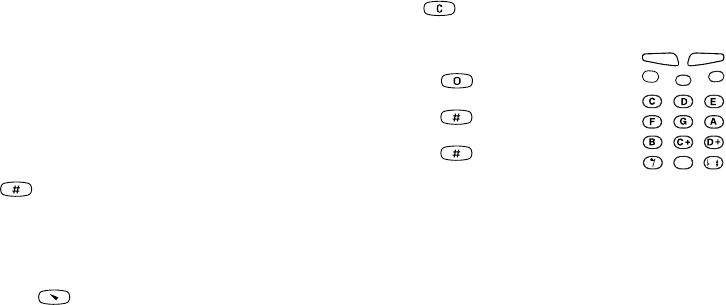
This is the Internet version of the user's guide. © Print only for private use.
Personalizing your phone 19
Tip: Use the volume keys on the side of the phone to
scroll silently.
Specific ring signals for personal calls
If your subscription includes the Calling Line
Identification service, you can assign a personal ring
signal to up to ten callers.
If the last seven digits of a caller’s number
correspond to a number you have specified, then that
caller’s ring signal is used.
You can include question marks in a phone number.
For example, 012345??? means that calls from phone
numbers between 012345000 and 012345999 will
have the same personal ring signal. Press and hold
to insert a question mark.
To set a specific ring signal for a caller
1. Scroll to Settings, YES, Sounds & Alerts, YES, Ring
Sounds, YES, Personal Rings, YES, Add New, YES.
2. Enter the caller’s number and press YES.
Press to retrieve a number from the phone book.
3. Select a ring signal and press YES.
Composing your own ring signal
You can compose ten different ring signals.
To compose or edit a ring signal
1. Scroll to Settings, YES, Sounds & Alerts, YES, My
Melodies, YES.
2. Select one of the melodies and press YES.
3. Press to remove notes.
4. Use the keypad to enter notes:
• Press and hold a key to enter a
long note.
• Press to raise the note one
octave.
• Press once to raise the note
one semitone.
• Press twice to lower the
note one semitone.
5. To listen to your melody, press YES.
6. Press YES again to save it or press NO to continue
composing.
Vibrating alert
You can choose to be notified of an incoming call by
the buzzing of the Vibrating alert. You can set the
phone’s Vibrating alert to one of the following:
•On (all the time)

This is the Internet version of the user's guide. © Print only for private use.
20 Personalizing your phone
•On If Silent (on when the ring volume is turned off
or when you have set the phone to silent)
•Off (all the time)
To set the Vibrating Alert
1. Scroll to Settings, YES, Sounds & Alerts, YES, Vibrating
Alert, YES.
2. Select the setting you want, and then press YES.
Message signal
You can set the message signal to clicks, tones or
silent.
•Select Message Alert from the Settings/Sounds &
Alerts menu and then select the signal you want.
Key sound
You can set the key sound to clicks, tones or silent.
•Select Key Sound from the Settings/Sounds & Alerts
menu and then select the key sound you want.
Minute minder
If you turn on the minute minder, you hear a beep once
every minute during a call.
•Select Minute Minder from the Call Information/Call
Timers menu and then select On or Off.
Menu language
Most SIM cards automatically set the menu language
to the language of the country where you bought your
SIM card, Automatic. If this is not the case, the preset
language is English.
To change the menu language
1. Scroll to Settings, YES, Language, YES, Menus, YES.
2. Select a language and press YES.
Note: You can always choose Automatic by pressing
8888 in standby.
You can always choose English by pressing 0000
in standby.
Display light
The display light can be set to automatic, off or on. In
automatic mode, the display light is turned off a few
seconds after you press the last key.
• Select Light from the Settings/Display menu, and then
select the alternative you want.
Pictures
Your phone comes with a number of pictures.
• Scroll to Extras, YES, Pictures, YES, where you can:
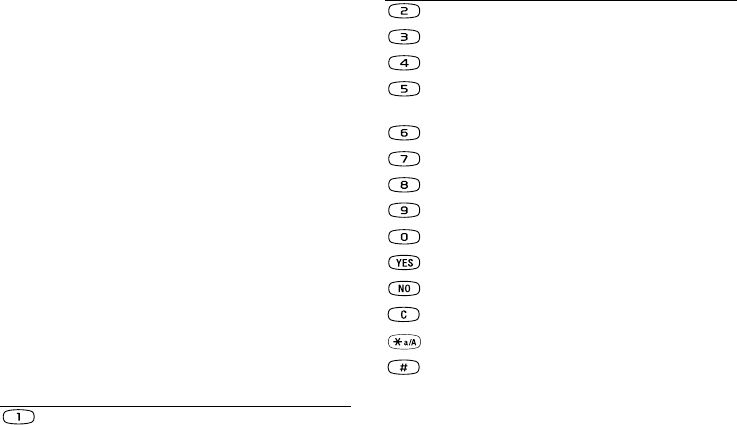
This is the Internet version of the user's guide. © Print only for private use.
Personalizing your phone 21
• Assign a picture to a number in the phone book.
When that person calls, the picture appears in the
display (provided your subscription supports the
Caller Identification service). See “To add a picture
to a phone book entry” on page 31.
• Edit a picture.
To draw your own picture
1. Scroll to Extras, YES, Pictures, YES, My Pictures, YES.
2. Press YES to start drawing with the picture editor.
3. Press YES twice to save the picture.
To edit a picture
1. Scroll to Extras, YES, Pictures, YES.
2. Select a picture group and press YES.
3. Select a picture and press YES to start editing with the
picture editor.
4. Press YES twice to save the picture.
The picture is saved in My Pictures.
Picture editor keys and functions
This table lists the keypad functions.
Key Use
Move the cursor up and left.
Move the cursor up.
Move the cursor up and right.
Move the cursor left.
Lift up, or put down, the pen. Press and hold
to switch between zoom and full size view.
Move the cursor right.
Move the cursor down and left.
Move the cursor down.
Move the cursor down and right.
Switch line thickness.
Open the Options menu.
Exit the picture editor.
Delete the picture.
Move the cursor 1, 5 or 10 spaces.
Switch between black and white pen color.
Key Use

This is the Internet version of the user's guide. © Print only for private use.
22 Personalizing your phone
To save a picture in My Favorites
1. Scroll to Extras, YES, Pictures, YES.
2. Select a picture group and press YES.
3. Select a picture and press .
4. Press YES to save the picture.
To delete a picture from My Favourites
1. Scroll to Extras, YES, Pictures, YES.
2. Select My Favorites and press YES.
3. Select a picture and press .
4. Press YES to delete the picture.
Background picture
Select a picture as background when in standby mode.
Your phone comes with 10 preset pictures. You can
also save an additional 10 pictures in your phone that
you either create yourself or download from Sony
Ericsson Mobile Internet. For more information, visit
www.SonyEricsson.com/mobileinternet/.
To set a picture as background
1. Scroll to Settings, YES, Display, YES, Background, YES,
Select Picture, YES.
2. Select a picture and press YES.
To turn on the background picture
1. Scroll to Settings, YES, Display, YES, Background, YES,
Activate, YES.
2. Select On and press YES.
Display sleep
Turn on the sleeping display to save power.
To turn on the sleeping display
1. Scroll to Settings, YES, Display, YES, Display Sleep,
YES.
2. Select On and press YES.
Time and date
The time is always displayed in standby mode.
To set the clock
1. Scroll to Settings, YES, Time and Date, YES, Set Time,
YES.
2. Enter the time and press YES.
If you select the 12-hour clock, you can alternate
between am and pm by pressing .
You can choose a 12-hour or a 24-hour clock.
• Select Time Format from the Settings/Time and Date
menu, then select the time format you want.
This is the Internet version of the user's guide. © Print only for private use.
Personalizing your phone 23
Date
When the phone is in standby mode, you can press
either of the volume keys to see today’s date.
To set the date
1. Scroll to Settings, YES, Time and Date, YES, Set Date,
YES.
2. Enter the date, and then press YES.
You can select another date format.
• Select Date Format from the Settings/Time and Date
menu, then select the date format you want.
Answering mode
When using a portable, handsfree unit, you can choose
to answer a call by pressing any key (except the NO
key) or set the phone to answer the call automatically.
To select answering mode
1. Scroll to Settings, YES, Handsfree, YES, Answering
Mode, YES.
2. Select an answering mode and press YES.
Start-up/Shut-down show
When you turn your phone on or off, the Sony Ericsson
start-up/shut-down show appears in the display. Your
operator’s own greeting may be shown instead.
If you want to interrupt the start-up show, press NO.
You can also create your own start-up show.
To select a start-up/shut-down show
1. Scroll to Settings, YES, Display, YES, User Greeting,
YES.
2. Select an existing show, or write your own greeting by
selecting Custom, then press YES.
You can also turn off the start-up/shut-down show by
selecting Off.
To turn the start up melody on or off
1. Scroll to Settings, YES, Display, YES, User Greeting,
YES.
2. Select a show and press YES.
3. Select Animation Sound, YES, On or Off, YES.
To create your own start-up show
1. Scroll to Settings, YES, Display, YES, User Greeting,
YES.
2. Select My animation, YES, Image, YES.

This is the Internet version of the user's guide. © Print only for private use.
24 Personalizing your phone
3. Draw your own picture, then press YES twice to save
the picture.
4. Select Animation Sound, YES, On or Off, YES.
5. Select Transition, YES. Decide how you want the start-
up show to move across the display, YES.
6. Select Preview to view the start-up show, YES.
Phone number display
You can store your own phone number(s).
•Select My Numbers from the Settings/Display menu. If
your number is not stored on your SIM card, you can
enter it yourself.
Keypad lock
You can lock the keypad to avoid dialing a number by
accident.
Note: Calls to the international emergency number
112 can still be made, even when the keypad is locked.
The keypad remains locked until you:
• answer an incoming call
• unlock the keypad
To lock the keypad manually
1. Press and hold .
2. Select Lock Keypad and press YES.
Automatic keylock
Automatic keylock means that if no keys are pressed
after 25 seconds, the keypad will lock.
To turn the automatic keylock on or off
1. Scroll to Settings, YES, Locks, YES, Auto Keylock, YES.
2. Select On or Off and press YES.
To unlock the keypad
1. Press and hold .
2. Select Turn off keylock? and press YES.
Phone name
You can choose a name for your phone.
To enter a phone name
1. Scroll to Settings, YES, Phone name, YES.
2. Select Edit and enter a name, press YES.

This is the Internet version of the user's guide. © Print only for private use.
Personalizing your phone 25
My Shortcuts
You can place your favorite functions in the My
Shortcuts menu. This enables you to quickly and easily
reach the functions you use most. When you buy your
phone, My Shortcuts contains a few functions which
you can remove if you wish.
To add a function to My Shortcuts
1. Scroll to My Shortcuts, YES, Edit Shortcuts, YES.
2. Select a function from the list by pressing .
3. Enter the position number you want for your function
in this menu and press YES.
To add another function, repeat steps 2 and 3.
To remove a function, repeat steps 1 and 2.
4. Press YES to exit the list.
Tip: Press and hold to reach the first submenu in
the My Shortcuts menu.
Profiles
A profile is a group of settings which are set to suit a
certain environment. For example, when you go to a
meeting, you can simply choose the Meeting profile
and a number of settings that suit a meeting are set –
the ring signal is turned off, etc.
Some phone accessories can activate a profile
automatically. For example, when you connect a
portable, handsfree to your phone, the Port H-free
profile is activated.
The profiles
There are five profiles in the phone:
• Normal
•Meeting
• Outdoors
• Port H-free (portable handsfree)
• Home
When you buy your phone, it is set to the Normal
profile. You cannot create more profiles, but you can
change the name of a profile, change the settings
included in a profile or add an accessory to a profile.
You cannot change the name of, or add any accessories
to, the Normal profile.
To choose a profile manually
1. Scroll to Settings, YES, Profiles, YES, Select Profile,
YES.
2. Select a profile and press YES.
This is the Internet version of the user's guide. © Print only for private use.
26 Personalizing your phone
To change the name of a profile
1. Scroll to Settings, YES, Profiles, YES, Edit Profile, YES,
Profile name:, YES.
2. Enter a new name and press YES.
To change a profile setting
1. Scroll to Settings, YES, Profiles, YES, Edit Profile, YES.
2. Select a setting and press YES.
3. Change the profile settings and press YES to confirm.
You can reset all profile settings to the way they were
set when you bought your phone:
•Select Reset Profiles from the Settings/Profiles menu.
Automatic activation
The profile Port H-free is automatically activated
when used with a portable handsfree. When you
disconnect your phone from the accessory, the profile
is changed back to the one which was active before, if
the current profile was activated automatically.
When you buy your phone, the automatic activation
is set to on for the Portable handsfree profile.
To turn automatic activation on or off
1. Scroll to Settings, YES, Profiles, YES, Edit Profile, YES,
Auto Activation, YES.
2. Select On or Off and press YES.
Note: A profile with no associated accessories, such as
Meeting or Normal, must be chosen manually.
Master reset
You can reset all the settings in the phone to the way
they were when you bought your phone.
Note: If you select Reset All, some pictures, melodies
and templates which came with your phone will be
deleted.
To reset the phone
1. Scroll to Settings, YES, Master Reset, YES, Reset
Settings, YES.
2. Enter the phone lock code (0000 or your new code, if
you have changed it) and press YES. See “The phone
lock” on page 56.

This is the Internet version of the user's guide. © Print only for private use.
Calling 27
Calling
This chapter gives information about the calling
functions that your phone supports.
Making calls
Before you can make and receive calls, you need to
turn on the phone and be within range of a network.
Making a call
1. Enter the area code and phone number.
2. Press YES.
Ending a call
•Press
NO to end the call.
Changing the earpiece volume
During a call, you can change the listening volume by
pressing the volume keys on the side of the phone.
• Press the upper key to increase the volume.
• Press the lower key to decrease the volume.
Turning off the microphone
During a call, you can turn off the microphone.
• Press and hold to turn off the microphone.
• To resume the conversation, press and hold
again.
Redialing a previously called number
In the Call List you can find the numbers for calls that
you have made, answered or missed.
To redial a previously called number
1. Press YES from standby mode to enter the Call List.
2. Press or to scroll through the list.
3. When the number you want to call is highlighted, press
YES to make the call. See “Call list” on page 30.
Automatic redialing
If a connection failed, and the display shows Retry?,
you can redial the number by pressing the YES key.
Your phone automatically redials (up to 10 times):
• until the call is answered.
• until you press a key or receive a call.
Making international calls
1. Press and hold until a + sign appears.
The + replaces the international prefix number of the
country from which you are calling.

This is the Internet version of the user's guide. © Print only for private use.
28 Calling
2. Enter the country code, area code (without the leading
zero) and phone number.
3. Press YES.
Making emergency calls
1. Enter 112 (the international emergency number).
2. Press YES.
Your Sony Ericsson phone supports the international
emergency number 112. This means that it can
normally be used to make an emergency call in any
country, with or without a SIM card inserted, if a GSM
network is within range.
Note: Some network operators may require that a SIM
card be inserted, and in some cases that the PIN has
been entered as well.
Emergency numbers
Some countries may not promote the
international emergency number, 112. Your
operator may therefore have stored local
emergency numbers on the SIM card, which work in
addition to the international emergency number.
To use another emergency number
1. Press to go to the Phonebook menu.
2. Press YES to select the menu.
3. Press to go to Special Numbers, YES, Emergency
Nos., YES.
4. Press or to go to the number you want,
then press YES to make the call.
Receiving calls
When you receive a call, the phone rings and the
display shows Answer?
If your subscription includes the Caller
Identification service and the caller’s network sends
the number, the caller’s number is shown in the
display. If you have saved the caller’s name and
number in the phone book, and added a picture to it,
the caller’s name and the picture is displayed. If the
network does not send the number, the display shows
Withheld.
Answering a call
• Press YES to answer a call.
Rejecting a call
• Press NO, or

This is the Internet version of the user's guide. © Print only for private use.
Calling 29
• Press either of the volume keys on the side of the
phone twice to reject a call.
The caller hears a busy tone if this is supported by the
caller’s network. If “Forwarding calls When Busy” is
on, the call is forwarded to the number you have
specified. See “Forwarding incoming calls” on page
34.
Missed calls
If you have missed a call, the message Missed calls: 1
appears in standby mode. (The number indicates the
number of missed calls.)
To check your missed calls
1. Press YES.
2. If you wish to call a number from the list, select the
number and press YES.
Press NO if you do not want to check your missed calls
now. You can always check them later.
• Select Missed Calls from the Call Information menu.
The notepad
If you want to make a note of a phone number during a
call, you can use your phone display as a notepad.
Use the number keys to enter the number. When you
end the call, the number remains in the display.
When you enter the number, the person at the other
end can hear the tones. You can turn the tones off (can
only be done during a call).
To turn the tone signals off during a call
1. Press until the Ongoing Call menu appears.
2. Press YES to select the menu.
3. Select Turn Off Tones, YES.
4. Press YES again to turn off the tone signals.
Showing and hiding your phone number
You can choose to show or hide your number
for a particular call, if this service is
supported by your subscription.
To hide or show your phone number
1. Enter the phone number you wish to call.
2. Press until the Call Information menu appears.
3. Press YES to select the menu.
4. Press again until Next Call is highlighted.

This is the Internet version of the user's guide. © Print only for private use.
30 Calling
5. Press YES to select Next Call.
6. Select Hide My Number or Show MyNumber and press
YES to make the call.
Encrypting
Ciphering is a built-in feature that encodes your calls
and messages to provide additional privacy.
An icon is shown in the display during a
call to indicate that encrypting is currently
not being provided by the network.
Call list
The Call List is a phone number log that saves
information (time, date, phone number and name)
about the last 20 dialled, answered and missed calls.
Once your list exceeds 20 calls, the oldest one is
deleted.
The calls are saved in chronological order, except
for the last dialled number, which is always displayed
in the first position. If you check a call within
24 hours, the time of the call is displayed. Otherwise,
the time is replaced by the date.
If the incoming call is a restricted number, the
display shows Withheld.
To call a number from the call list
1. Press YES when the phone is in standby mode.
2. Select the number you want to call and press YES.
Tip: You can also select the Call List from the Call
Information menu.
Clearing the call list
• Select Clear Call List from the Call Information/
Options menu.
To turn the call list on or off
1. Scroll to Call Information, YES, Options, YES, Call
Listing, YES.
2. Select On or Off and press YES.
The list is cleared if you select Off, and then accept to
clear the list.
Phone book
Your phone has a phone book in which you can save
numbers and accompanying names (an entry).
This means that you can retrieve a number from the
phone book instead of entering the number again.

This is the Internet version of the user's guide. © Print only for private use.
Calling 31
Saving a number
When you want to save a phone number, you use the
Add Number function in the Phone Book menu. If you
have already made and received calls, you can find
these numbers in the Add numbers list.
Every phone number you save also gets a position
number. If you want to, you can choose to sort your
phone book entries according to their position number
instead of the name.
If you intend to use your phone both at home and
abroad, it is a good idea to save all phone numbers as
international phone numbers, i.e. with the + sign,
followed by the country code, the area code and the
phone number. Press and hold to enter the + sign.
To save a number together with a name
1. Scroll to Phonebook, YES, Add Number, YES.
2. Select Add New or any of the numbers from the list by
pressing YES.
3. Enter the phone number that you want to save and
press YES.
4. Enter a name that you want to associate with the phone
number and press YES. See “Entering letters” on
page 15.
5. Press YES again to save the entry in the suggested
position.
Pictures and personal rings
You can add a picture to a phone book entry.
To add a picture to a phone book entry
1. Scroll to Phonebook, YES, CLI Pictures, YES.
2. Select Add new?, press YES.
3. Press to go to the phone book, YES.
4. When the phone book entry is highlighted, press YES.
5. This takes you to Pictures. Select a picture and press
YES.
• Select Personal Rings to add a personal ring signal.
Calling a number saved in the phone book
You use the Find and Call function to call a number
that you have saved in the phone book.
To call a number saved in the phone book
1. Press and hold until the Find and Call menu
appears.
2. Enter the name or the first few letters of the name (sort
order by name) associated with the number that you
want to call and press YES.
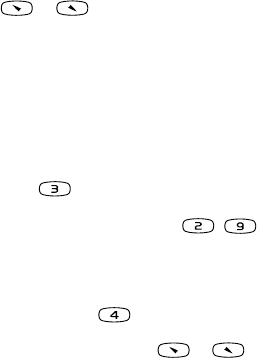
This is the Internet version of the user's guide. © Print only for private use.
32 Calling
If the name displayed is not the one you want, press
or until you find the correct name and
number.
3. Press YES to make the call.
Shortcuts to phone book entries
You can call the phone numbers that you have saved in
positions 1–9 by entering the position number in
standby, and then pressing YES.
Example:
• Press and then
YES.
When in standby, you can find an entry by pressing
and holding one of the keys – to find an
entry beginning with the first letter on that key, or the
closest following.
Example
• Press and hold to get to the first entry beginning
with the letter “G” (or the closest following). Then
scroll up or down, using or . When you find
the entry you want, press YES to make the call.
Ask to save
If Ask to Save is on, you are asked if you want to save
any called or answered number that is not already
saved in your phone book.
To turn the Ask to Save function on or off
1. Scroll to Phonebook, YES, Options, YES, Ask to Save,
YES.
2. Select On or Off and press YES.
Note: Your subscription must support the Caller
Identification Service, if you want to save answered
numbers.
Keeping the phone book up to date
You can change and delete names and numbers from
the phone book.
To edit an entry
1. Scroll to Phonebook, YES, Find and Edit, YES.
2. Enter the name (or the first few letters) for the entry
that you wish to edit and press YES.
3. Press YES to select the entry.
4. Select Edit and press YES.

This is the Internet version of the user's guide. © Print only for private use.
Calling 33
5. When you have finished editing, press YES to save your
changes.
To delete an entry from the phone book
1. Scroll to Phonebook, YES, Find and Edit, YES.
2. Enter the name (or the first few letters) for the entry
that you wish to edit and press YES.
3. When the entry you want to delete is highlighted, press
.
4. Press YES to confirm.
Sort order
You may change the sort order of your phone book
entries so that they are sorted according to their
position number instead of the name. This means that
you search for the position number when you use the
Find and Call or the Find and Edit functions.
To choose a sort order
1. Scroll to Phonebook, YES, Options, YES, Sort Order,
YES.
2. Select a sort order and press YES.
Phone book memories
Your phone book entries are saved in the memory on
your SIM card. The number of entries you can save
depends on your SIM card. By saving your entries on
the SIM card, you still have access to them if you use
the card with another phone.
You can also save your entries in the phone memory.
The phone memory holds 100 positions in which your
entries are saved when all SIM positions are occupied.
If you save your entries in the phone memory, you still
have access to them if you use another SIM card with
your phone.
Choosing where to save an entry
When you save an entry and are asked to enter the
position number, you can do the following:
• To save the number in the first empty position
suggested, press YES.
• To save the number in another position, press to
delete the position number, enter a new position
number and press YES.
• To save the number in the phone memory, you first
need to know how many positions you have got on
your SIM card. You can check this in the Memory
Status menu, see page 34. If, for example, you have
This is the Internet version of the user's guide. © Print only for private use.
34 Calling
200 positions on your SIM card, you can enter position
number 201 to save a number in the first position of the
phone memory.
Overwrite protection
If you try to save a phone number in a position which
already contains a phone number, the message
Overwrite? appears together with the name saved in
that position. You now have two options:
• Press YES to replace the number with the new one.
• Press NO if you do not want to replace the old number.
Enter a new position and press YES.
Checking the status of the memory
You can check how many memory positions you have
in your memories and how many of them you have
used.
To check the status of the memories
• Scroll to Phonebook, YES, Memory Status, YES.
If you have saved entries in the phone memory, you
can delete them.
To delete all entries from the phone memory
1. Scroll to Phonebook, YES, Options, YES, Delete All,
YES.
2. Press YES again.
Note: The entries on your SIM card are not deleted.
Copy phone book entries
You can copy the phone book entries between your
phone’s memory and the SIM card. The number of
entries that can be saved depends on the type of SIM
card.
• To copy entries to the SIM card, scroll to Phonebook,
YES, Options, YES, Copy to SIM.
• To copy entries to the phone, scroll to Phonebook, YES,
Options, YES, Copy from SIM.
Groups
You can create a group of phone book entries. You can
then send a text message to all members of that group
at the same time. See “Text messages (SMS)” on
page 43.

This is the Internet version of the user's guide. © Print only for private use.
Calling 35
To create a new group
1. Scroll to Phonebook, YES, Groups, YES, Add New, YES.
2. Enter a name for the group and press YES.
3. Scroll to Add New and press YES.
4. Select an entry in your phone book and press YES.
5. To add the next member, repeat steps 3 and 4.
6. Press NO to leave the menu.
To add a member to an existing group
• Select the group you want and then select Input/Add
New.
Your voice mail service
The answering service of your network operator allows
callers to leave a voice message when you cannot
answer your calls. Depending on your operator, you
are informed that someone has left a message in
different ways.
Most operators send a text message (SMS), asking
you to call your voice mail service, for example. See
“Text messages (SMS)” on page 43 for more
information.
Other operators send a specific voice mail
indication. If this is the case, the voice mail icon
appears in the display.
Using your voice mail service
You can save the number to your voice mail service,
making it easier for you to call your voice mail.
To save your voice mail number
1. Scroll to Messages, YES, Options, YES, Voicemail No.,
YES.
2. Enter your Voice Mail number and press YES.
To call your voice mail service
• Press and hold from standby.
You can also select Call Voice Mail from the Messages
menu.
Receiving a voice mail
When you receive a voice mail, your phone beeps and
the message New voicemail. appears in the display.
• Press YES to listen to the voice mail.
If you want to listen to it later, press NO.
Call time and call cost
During a call, the duration of the call is shown in the
display. If you subscribe to cost information, the call
cost (or the number of call units) is displayed instead.

This is the Internet version of the user's guide. © Print only for private use.
36 Calling
Call time
You can check the duration of your Last Call,
Outgoing Calls, Incoming calls and the Total Time.
To check the call time
1. Scroll to Call Information, YES, Call Timers, YES.
2. Select a call time and press YES.
3. Select Reset Timers if you want to reset a call time
counter.
Call cost
You can check the cost of your Last Call and
the Total Time of your calls.
To check the call cost
1. Scroll to Call Information, YES, Call Costs, YES.
2. Select a call cost and press YES.
3. Select Clear Total Cost to reset the counter.
Note: If you subscribe to cost information, you must
enter your PIN2 to clear the cost or time counter.
Determining the call cost
You can use the ‘rate’ function to specify the price per
call unit. If you do not specify a price per call unit, the
number of call units is displayed instead.
To enter the price per call unit
1. Scroll to Call Information, YES, Call Costs, YES, Set
Rate, YES.
2. Enter your PIN2 and press YES.
3. Select Change Rate and press YES.
4. Enter the code for the currency you want, (for example
USD for US Dollars), and press YES.
5. Enter the price per call unit and press YES.
To enter a decimal point, press .
Credit limit for calls
If supported by your network and your
subscription, you can enter a total amount of
money that can be used for making calls.
When the amount reaches zero, no more calls
can be made. Please note that the credit limit is only an
estimated value.

This is the Internet version of the user's guide. © Print only for private use.
Calling 37
To set a specific credit limit
1. Scroll to Call Information, YES, Call Costs, YES, Set
Credit, YES.
2. Enter your PIN2 and press YES.
3. Select Change Credit and press YES.
4. Enter an amount and press YES.
To set an unlimited credit, select Unlimited.
Forwarding incoming calls
If you cannot answer an incoming voice call, you can
forward it to another number.
For voice calls, you can choose between the
following forwarding alternatives:
•All Voice Calls – forward all voice calls.
•When Busy – forward calls if you are already on the
phone.
•Not Reachable – forward calls if your phone is turned
off or if you are unreachable.
•No Reply – forward calls that you do not answer within
a specified time limit (operator service).
To turn on call forwarding
1. Scroll to Settings, YES, Call Options, YES, Forward
calls, YES.
2. Select a forwarding option and press YES.
3. Select Activate and press YES.
4. Enter the phone number to which you want your calls
to be forwarded and press YES, or retrieve it from the
phone book by pressing .
Note: When the Restricted Calls function is on, some
Forwarding Calls options cannot be activated. See
“Restrict calls” on page 40.
To turn off call forwarding
1. Scroll to Settings, YES, Call Options, YES, Forward
calls, YES.
2. Scroll to a forwarding option and press YES.
3. Select Cancel and press YES.
4. Select Get Status to check if a forwarding option is on
or off.
You can check the status of all forwarding options.
• Select Check All from the Settings/Call Options/
Forward calls menu.
More than one call
Your phone can handle more than one call
simultaneously. You can, for example, put an ongoing

This is the Internet version of the user's guide. © Print only for private use.
38 Calling
call on hold while you make or answer a second call,
and then switch between the two calls.
You can also set up a conference call to have a joint
conversation with up to five people.
Call waiting service
If the call waiting service is on, you hear a beep if you
receive a second call during an ongoing call.
To turn the call waiting service on or off
1. Scroll to Settings, YES, Call Options, YES, Call
Waiting, YES.
2. Select Activate or Cancel and press YES.
Select Get Status to check if call waiting is on or off.
Making a second call
1. Put the ongoing call on hold by pressing YES.
2. Enter the number you wish to call and press YES.
Press and hold to retrieve a number from the
phone book.
Note: You can only put one call on hold.
Receiving a second call
If the Call Waiting service is on, you hear a beep in the
earpiece if you receive a second call. A list of
alternatives, Answer, Busy and Release & Answ., is
shown in the display. You can do one of the following:
Put the ongoing call on hold and answer the
waiting call
• Press YES to answer the waiting call.
The held call is marked in grey and the ongoing call is
marked in black.
Continue the ongoing call and reject the waiting
call
• Select Busy.
End the ongoing call and answer the waiting call
• Select Release & Answ..
One ongoing call and one call on hold
When you have one ongoing call and one call on hold,
you can do one of the following:
Switch between the two calls
• Press YES.

This is the Internet version of the user's guide. © Print only for private use.
Calling 39
End the ongoing call and return to the call on hold
1. Press NO.
2. Press YES.
End both calls
•Press
NO twice.
Join the two calls into a conference call
• Scroll to Ongoing Call, YES, Join Calls, YES.
Receiving a third call
You cannot answer a third call without ending one of
the first two calls.
End the ongoing call and accept the waiting call
• Select Release & Answ..
The waiting call becomes active and the call on hold
remains on hold.
Reject the waiting call
• Select Busy.
Conference calls
You can include up to five participants in a
conference call. To create a conference call,
you must have one ongoing call and one call
on hold.
To join the two calls into a conference call
• Scroll to Ongoing Call, YES, Join Calls, YES.
To add a new participant
1. Press YES to put the conference group on hold.
2. Call the next person you wish to include in the
conference group.
3. Scroll to Ongoing Call, YES, Join Calls, YES.
You can include up to five participants in the
conference call by repeating steps 1 to 3 above.
To extract a participant
1. Scroll to Ongoing Call, YES, Extract Part, YES.
2. Select a participant and press YES.
To rejoin the participant
• Scroll to Ongoing Call, YES, Join Calls, YES.

This is the Internet version of the user's guide. © Print only for private use.
40 Calling
To release a participant
1. Scroll to Ongoing Call, YES, Release Part, YES.
2. Select a participant and press YES.
To release all participants
• Scroll to Ongoing Call, YES, Release All, YES.
You can put a conference on hold and make a new call.
You can switch between the calls in the same way as
when switching between two normal calls.
To end the conference call
• Press NO.
Restrict calls
The Restrict Calls service allows you to
restrict certain types of calls being made and
received.
You need a password, which comes with your
subscription, to activate or cancel a call restriction.
The following calls can be restricted:
• all outgoing calls, All Outgoing
• all outgoing international calls, Outgoing Intl.
• all outgoing international calls except to your home
country, Outg. Intl. Roam
• all incoming calls, All Incoming
• all incoming calls when you are abroad (when
roaming), Inc. when Roam
To turn a call restriction on or off
1. Scroll to Settings, YES, Call Options, YES, Restrict
Calls, YES.
2. Select an option and press YES.
3. Select Activate or Cancel and press YES.
4. Enter your password and press YES.
• To check the status of a call restriction, select the call
restriction and then, Get Status.
• To turn off all call restrictions, select Cancel All.
• To change the password, select Change Pwd..
Note: If you forward incoming calls, you cannot
activate some Restrict Calls options. Likewise, if you
restrict calls, you cannot activate some Forward Calls
options.
Fixed dialing
The Fixed Dialing function allows calls to be
made only to certain numbers saved on the
SIM card. If an attempt is made to call other

This is the Internet version of the user's guide. © Print only for private use.
Calling 41
numbers, the message Number not permitted. appears
in the display. Fixed dialing requires a SIM card that
allows fixed numbers to be saved. The fixed numbers
are protected by your PIN2.
• Partial numbers can be saved. For example, storing
0123456 allows calls to be made to all numbers
starting with 0123456.
• Numbers that include question marks can be saved.
For example, storing 01234567?0, allows calls to be
made to numbers from 0123456700 to 0123456790. To
enter a question mark, press and hold .
Note: Calls to the international emergency number
112 can still be made, even when Fixed Dialing is on.
To turn fixed dialing on or off
1. Scroll to Phonebook, YES, Options, YES, Fixed dialing,
YES.
2. Enter your PIN2 and press YES.
3. Select On or Off and press YES.
To save a fixed number
• Select Add New from the Phonebook/Fixed Numbers
menu, then enter the number.
Closed user groups
The Closed User Group function is a way of
lowering call costs. On some networks it is
cheaper to make calls within a call group.
Your network operator can place certain numbers in
groups. You can have a maximum of 10 groups.
To add a group
1. Scroll to Settings, YES, Call Options, YES, Closed
Groups, YES, Edit List, YES.
2. Scroll to Add New and press YES.
3. Enter the name of the user group and press YES.
4. Enter the index number and press YES.
You get the index number from your operator.
To activate a group
1. Scroll to Settings, YES, Call Options, YES, Closed
Groups, YES, Edit List, YES.
2. Select a group and press YES.
3. Select Activate and press YES.
Calls can only be made within the selected group.
This is the Internet version of the user's guide. © Print only for private use.
42 Calling
To call outside closed user groups
1. Scroll to Settings, YES, Call Options, YES, Closed
Groups, YES, Open Calls, YES.
2. Select On and press YES.
Accept calls
With the Accept Calls service, you can choose to
receive calls only from certain numbers. Other calls
are rejected by a busy tone. You have to save the
numbers that you want to receive in an Accepted
Callers List. The numbers must first be saved in your
phone book. The rejected calls are saved in the Call
List.
To add numbers to the Accepted Callers List
1. Scroll to Settings, YES, Call Options, YES, Accept Calls,
YES, Accepted List, YES.
2. Scroll to Add New, YES.
This takes you to the phone book.
3. Select an entry and press YES.
To set the accept calls option
1. Scroll to Settings, YES, Call Options, YES, Accept Calls,
YES, Accept Options, YES.
2. Select an option and press YES.
Setting network preferences
When you turn on the phone, it automatically searches
for your home network. If this is not within range, you
may use another network, provided your network
operator has an agreement that allows you to do so.
This is called roaming.
To select a network
1. Scroll to Settings, YES, Networks, YES, Select Network,
YES.
2. Select a network and press YES.

This is the Internet version of the user's guide. © Print only for private use.
Messaging 43
Messaging
Text messages (SMS)
You can use the Short Message Service
(SMS) to send and receive text messages
consisting of up to 160 characters.
If the number to your service center is not
saved on your SIM card, you must specify the number
yourself. Otherwise you cannot reply to received
messages or send your own messages.
Your phone also features enhanced messaging
services that allow you to add pictures, animations,
sounds and melodies to text messages.
To check the number to your service center
1. Scroll to Messages, YES, Options, YES, Service center,
YES.
If no number is found, select Add New and press YES.
2. Enter the number, including the international + sign
and country code, and press YES.
Note: The number to your service center is provided
by your operator.
To send a text message
1. Scroll to Messages, YES, Write New, YES.
2. Enter your message and press YES. See “Entering
letters” on page 15.
3. Enter the recipient’s phone number or retrieve it from
the phone book by pressing .
4. Press YES to send the message.
If you want to send the message later, press NO twice
when you are asked to enter the phone number. The
message is saved in the Unsent list in the Messages
menu.
To insert an object in a text message
1. Scroll to Messages, YES, Write New, YES.
2. While writing your message press and hold to
enter the option menu.
3. Select Add Symbol or Insert Object, YES.
4. Select Picture, Sound, Melody or Animation YES.
5. Select an object or symbol, YES. Then press YES again
to confirm.
Text formatting
You can change the style, size and alignment of the
text in a text message.

This is the Internet version of the user's guide. © Print only for private use.
44 Messaging
To format the text in a text message
1. Scroll to Messages, YES, Write New, YES.
2. Write the text message.
3. Press and hold .
4. Select Text Format, YES. Then select Text Size, Text
Style or Alignment, YES. Select a format and press YES.
Long messages
A text message can contain up to 160 characters. You
can send a longer message by linking two or more
messages. Please note that you are charged for the
number of linked messages.
To turn long messages on
• Scroll to Messages, YES, Options, YES, Long messages,
YES, On, YES.
Sending a text message to a group
You can send text messages to group that you have
specified and saved in your phone book. See “Groups”
on page 34.
To send a text message to a group
1. Scroll to Messages, YES, Write New, YES.
2. Enter your message and press YES.
3. Press , select Groups and press YES.
4. Select a group and press YES.
Note: You will be charged for each group member.
Message options
You can set a default value for the message options
below, or you can turn on the Set on send option where
you choose the settings each time you send a message.
• Message Type – The phone supports different types of
messages. Your service provider may offer the facility
of converting a text message into a format (e-mail or
fax, for example) that suits the equipment that is going
to receive the message.
• Validity Period – If your message cannot be delivered,
for example, if the recipient has turned off the phone,
your service center can save the message to send it
later.
• Request Reply – Include a reply request if you want
the recipient of your message to reply.
• Status Request – Check if a message has been
delivered.
To set a default message option
1. Scroll to Messages, YES, Options, YES.

This is the Internet version of the user's guide. © Print only for private use.
Messaging 45
2. Select an option, YES.
3. Select Set default, YES.
4. Select an option from the list, YES.
To turn set on send on or off
• Repeat steps 1 and 2 above, then select Set on send,
YES.
Te m p l a t es
If you have one or more messages that you send often,
you can save these as templates. You can save
20 templates consisting of up to 60 characters each.
Your phone may come with a set of templates that
your operator or service provider has prepared for you.
These templates appear in the list of templates,
indicated by a letter icon with a dotted sheet.
To create a template
1. Scroll to Messages, YES, Templates, YES, Add New,
YES.
2. Enter the message and press YES.
3. To send the template now, press YES when Use
template to create message now? appears and proceed
as described in “To send a text message” on page 43.
Press NO if you do not want to send the template now.
To send a template later, select it from the Templates
list in the Messages menu, and proceed as described in
“To send a text message” on page 43.
Message counter
You can check the number of text messages that you
have sent.
To check the number of sent messages
• Scroll to Call Information, YES, Call Costs, YES, Sent
SMS, YES.
Select Clear SMS Count to reset the counter.
Receiving a message
When you receive a message, the
phone beeps, the indicator light rapidly
flashes green and the message New
message. Read now? appears in the display.
To read the message now
1. Press YES.
2. Press and to scroll through the message.
3. When you have read the message, press YES. A new
menu with different options appears. These options are
described on the following pages.
New message.
Read now?

This is the Internet version of the user's guide. © Print only for private use.
46 Messaging
Note: If the sender of the message wants you to reply,
the message ‘Reply requested Reply?’ appears in the
display. Press again to reply. If you do not want
to reply, press .
To read the message later
• Press NO to save the message in your Inbox in the
Messages menu.
To reply to a message
1. When you have read the message, press YES.
2. Select Reply in the option list and press YES.
3. Select the message you want to send as a reply and
press YES. You can choose between:
• Send new
• Include this Message. The message you received is
included in your answer.
• Any templates.
4. Write your message and press YES.
To forward a message
1. When you have read the message, press YES.
2. Select Forward and press YES.
Continue in the same way as when sending a new text
message.
To call a phone number found in a message
• When the number is highlighted, press YES.
To call the sender of the message
1. When you have read the message, press YES.
2. Select Call and press YES.
To read the next message
1. When you have read the message, press YES.
2. Select Read Next and press YES.
To delete a message
1. When you have read the message, press YES.
2. Select Delete and press YES.
Tip: To delete a message from your Inbox, select the
message and press .
Saving incoming messages
Incoming messages are saved in the phone
memory. The phone memory can hold up to
15 messages. When the phone memory is full, a
flashing envelope in the display indicates that
you have to empty the inbox to be able to
receive new messages.

This is the Internet version of the user's guide. © Print only for private use.
Messaging 47
If the phone memory becomes full of unread
messages, new messages are automatically saved on
the SIM card. Messages that are saved on the SIM card
remain there until you delete them.
To save a message on the SIM card
1. When you have read the message, press YES.
2. Select Save and press YES.
E-mail addresses
You can save e-mail addresses to be used when you
want to send a text message as an e-mail. You can save
10 e-mail addresses.
To save an e-mail address
1. Scroll to Phonebook, YES, Email Addresses, YES, Add
New, YES.
2. Enter an e-mail address and press YES.
3. Enter a name and press YES.
Area information
The ordinary Short Message Service is a
personal service that carries your private
messages. Area Information is another type of
text message that is sent to all subscribers in a certain
network area.
This information could, for example, be a local
traffic report or the phone number of a local taxi
company.
To turn area information on or off
1. Scroll to Messages, YES, Options, YES, Area Info., YES,
Reception.
2. Select On or Off and press YES.
Area information codes
Please refer to the information provided by your
operator for more information about the area
information codes.
To enter an area information code
1. Scroll to Messages, YES, Options, YES, Area Info., YES,
Edit List, YES, Add New, YES.
2. Enter the new code and press YES.
Receiving an area message
When you receive an Area Information message, the
message automatically appears in the display. You read
the message in the same way as you read an ordinary

This is the Internet version of the user's guide. © Print only for private use.
48 Using mobile Internet
text message. You cannot save area messages. When
you have read the message and press YES or NO, it is
deleted.
Cell information
The “Cell information channel” is used by
some network operators for sending messages
to their subscribers within a certain network
area. You read messages on the Cell
information channel in the same way as when reading
area messages.
To turn on the channel, select Cell Information from
the Messages/Options menu and then select On.
Using mobile Internet
Your phone has a WAP (Wireless Application
Protocol) browser which is designed to bring a
modified Internet to your mobile phone. A wide range
of services are available, for example, news,
entertainment, timetables, reservations, banking, e-
commerce, positioning and e-mail.
Before you start
To use the mobile Internet you need
1. A phone subscription that supports data
transmission.
2. A correctly set WAP profile, including GSM
data settings, for WAP browsing.
Note: The settings may already be entered when you
buy the phone, or you can receive the settings from
your network operator or your service provider in a
text message.
This is the Internet version of the user's guide. © Print only for private use.
Using mobile Internet 49
To request settings from Sony Ericsson Mobile
Internet
1. Use a PC to go to www.SonyEricsson.com. By using
the WAP and E-mail Configurator, you can request that
a text message be sent to your phone with the settings
you need.
2. When the message arrives, New settings. Install?
appears:
• Press YES to install the new settings or
• Press NO to cancel installation. A new request for
settings is then required, as in step 1.
To set up a WAP profile and a GSM data account
1. Scroll to WAP Services, YES, WAP Settings, YES.
2. Select a WAP profile and press YES.
3. Scroll to Gateway, YES, User ID, YES.
4. Enter the User ID for your gateway and press YES.
5. Select Password and press YES.
6. Enter the password for your gateway and press YES.
7. Select IP Address and press YES.
8. Enter the IP address of your gateway and press YES.
An IP address looks something like this:
136.225.37.163.
Note: An IP address consists of four groups of digits,
with a maximum of three digits in each group. If one of
your digit groups consists of only one or two digits,
you have to enter a zero (0) in front of the original digit
for each digit that is missing. For example, to enter the
IP number above, 136.225.37.163, write
136.225.037.163.
9. Scroll to GSM Data, YES, Phone Number, YES.
10.Enter the phone number you use with your GSM Data
connection and press YES.
11.Scroll to User ID and press YES.
12.Enter the User ID for your GSM Data Connection and
press YES.
13.Scroll to Password and press YES.
14.Enter the password for your GSM Data Connection
and press YES.
You have now entered the settings you need to start the
WAP browser.
Using WAP
To select a WAP profile
1. Scroll to WAP Services, YES, Select Profile, YES.
2. Select a Select Profile, YES.

This is the Internet version of the user's guide. © Print only for private use.
50 Using mobile Internet
To start browsing
• Scroll to WAP Services, YES, Enter Address, YES.
Enter the WAP address, YES.
To exit the browser
• Press and hold NO. Remain connected? appears.
• Disconnect completely, press NO.
Options When Browsing
When browsing, you can reach different browsing
options such as links or special features by pressing
and holding . The options may vary depending on
the WAP page you are visiting.
To change the homepage of a WAP profile
1. Scroll to WAP Services, YES, WAP Settings, YES.
2. Select the profile whose homepage you want to
change, YES.
3. Scroll to Chg. Homepage, YES.
4. Enter the name of the homepage, YES.
5. Enter the address of the homepage, YES.
To work with your bookmarks when not browsing
1. Scroll to WAP Services, YES, Bookmarks, YES.
2. Select the bookmark you want to work with, YES.
3. Select one of the following submenus, YES:
•Go to Bookmark. Go to the marked WAP page.
•Edit Bookmark. Edit the name and/or the WAP
address of the bookmark.
•Delete. Delete the bookmark.
•Send as Link. This creates a text message in which
the WAP address is sent as a link. You can add a
comment if you wish.
To empty the cache memory
1. Scroll to WAP Services, YES, Clear Cache, YES.
2. Empty cache? appears, YES.
Security
To establish secure connections when using certain
WAP services, you need to have certificates saved
in your phone. Your phone may already contain
certificates when you buy it. You can also download
certificates from certain WAP sites, or receive them
from a service provider.
To turn on a secure connection
1. Scroll to WAP Services, YES, WAP Settings, YES.
2. Select the profile you want to edit.
3. Select Gateway, YES, IP Settings, YES, Security, YES.
4. Select On, YES.
This is the Internet version of the user's guide. © Print only for private use.
Using mobile Internet 51
To check the certificates in your phone
1. Scroll to WAP Services, YES, WAP Settings, YES,
Common, YES.
2. Scroll to Security, YES, select Trusted Certif. or Client
Certif., YES.
Locks (PIN codes)
PIN codes are used to protect your subscription from
unauthorized use, when accessing certain WAP sites,
and to authorize transactions. Your PIN code acts as a
signature when you confirm a transaction.
Note: These codes are supplied by your network
operator or service provider.
A Locks setting may appear in the Security sub menu.
To go to the Locks menu
• Scroll to WAP Services, YES, WAP Settings, YES,
Common, YES, Security, YES, Locks, YES.
Transaction contracts
You can check which transactions you have made with
your phone when browsing. Each time you confirm a
transaction with your signature lock code, a record is
saved in your phone. The contract contains details of the
transaction.
To check your transaction records
• Scroll to WAP Services, YES, WAP Settings, YES,
Common, YES, Security, YES, Contracts, YES.
WAP push messages
A service provider can send updated news or new
WAP settings to your phone in a push message.
Accepting or rejecting push messages
If you do not want to receive push messages, you can
turn off the Push access. This setting is valid for all
your WAP profiles.
To turn the push access on or off
1. Scroll to WAP Services, YES, WAP Settings, YES,
Common, YES, Push Access, YES.
2. Select On or Off.

This is the Internet version of the user's guide. © Print only for private use.
52 More features
Receiving push messages
When you receive a push message, it comes to the
Push Inbox. You can respond to a push message as
follows:
•Postpone. Saves the push message so that you can load
and see it later.
•Load. The browser starts and loads the pushed WAP
page.
•Delete. Deletes the push message.
More features
Calendar
In the calendar you can add a maximum of 25 tasks for
things that you have to remember. The tasks can be
edited or deleted.
To add a task
1. Scroll to Extras, YES, Calendar, YES.
2. Select Add task?, YES.
3. Enter a description, YES.
4. Enter the start/end dates and times, YES.
5. Scroll to Continue?, YES.
6. Set a reminder, if required, or select None and press
YES to save.
Note: If you select Set Reminder, enter the alarm date,
YES and the alarm time,YES to save the task.
To view a task
1. Scroll to Extras, YES, Calendar, YES.
2. Select one of the options below, YES.
•View Today. Press or to see the next or
previous task.
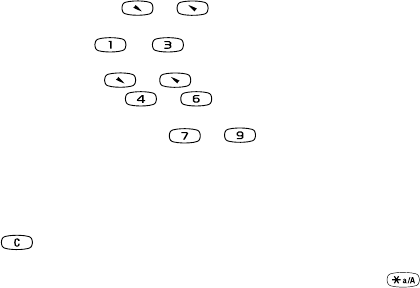
This is the Internet version of the user's guide. © Print only for private use.
More features 53
•View All Tasks. Press or to see the next
or previous task.
•View week. Press or to jump to the next
or previous week.
•View Month. Press or to select the next
or previous day. Press or to jump to the
next or previous month. Press YES to see the tasks
for the selected month. Press or to jump
to the next or previous year.
To delete a task
1. Scroll to the task that you want to delete as described
in “To view a task” on page 52.
2. Press to delete the task.
Note: To delete all tasks, scroll to Extras, YES,
Calendar, YES, Delete All, YES.
To edit a task
1. When the task is displayed, press YES.
2. Select Edit, YES.
3. Edit the task, YES, edit the date, YES, edit the reminder,
YES.
Alarm clock
The phone has an alarm clock which rings at the time
set, even if the phone is turned off. The alarm rings for
60 seconds and is repeated every nine minutes for
60 minutes until you turn it off.
To set the alarm
1. Scroll to Extras, YES, Time, YES, Alarms, YES, Alarm,
YES.
2. Enter the time and press YES.
To set a recurrent alarm
1. Scroll to Extras, YES, Time, YES, Alarms, YES,
Recurrent alarm, YES.
2. Enter the time and press YES.
3. Press to select the days you want to recur. Press
YES to exit the menu.
You can view the days in the Recurrence rule sub-
menu.
To turn the alarm signal off
• Press any key to turn the alarm off when it rings.
If you do not want the alarm to be repeated, press YES.
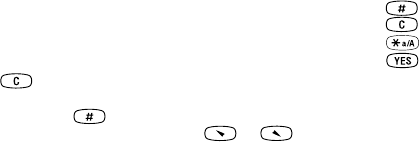
This is the Internet version of the user's guide. © Print only for private use.
54 More features
To turn the alarm function off
1. Scroll to Extras, YES, Time, YES, Alarms, YES, Alarm,
YES.
2. Select Cancel and press YES.
To change the alarm signal
1. Scroll to Settings, YES, Sounds & Alerts, YES, Alarm
Signal, YES.
2. Select a signal and press YES.
Stopwatch
The phone has a built-in stopwatch.
To run the stopwatch
1. Scroll to Extras, YES, Time, YES, Stopwatch, YES.
2. Press YES to start the stopwatch.
3. Press YES again to stop it.
4. Press to reset the stopwatch.
Tip: By pressing when the stopwatch is running,
you can store up to 9 lap times. Press or to
check your lap times.
Note: The stopwatch is turned off if you receive a call
or text message, or if you exit the stopwatch menu.
Timer
The phone has a built-in 24-hour timer. You set the
time you want and when that time is up, the phone
beeps.
To set the timer
1. Scroll to Extras, YES, Time, YES, Timer, YES.
2. Enter the time and press YES to start the timer.
3. When the alert sounds, press any key to turn it off.
Calculator
The phone has a built-in calculator, which can add,
subtract, divide and multiply.
• Press to get +, -, x, /.
• Press to delete the figure.
• Press to enter a decimal point.
• Press to view the sum.
This is the Internet version of the user's guide. © Print only for private use.
Security 55
Games
Your phone has several games. To view help texts on
how to control the games, scroll to Help.
To start a game
1. Scroll to Extras, YES, Games, YES.
2. Select a game, YES.
3. Select New Game or Resume Game, YES.
4. Start the game.
Security
The SIM card lock
The SIM card lock protects your subscription, but not
your phone itself, from unauthorized use. If you
change SIM cards, the phone still works with the new
SIM card.
Most SIM cards are locked at the time of purchase.
If the SIM card lock is on, you have to enter a “PIN”
(Personal Identity Number) every time you turn on
your phone.
If you enter your PIN incorrectly three times in a
row, the SIM card is blocked. This is indicated by the
message PIN blocked.. To unblock it you need to enter
your “PUK” (Personal Unblocking Key). Your PIN
and PUK are supplied by your operator.
To unblock your SIM card
1. PIN blocked. appears in the display.
2. Enter your PUK and press YES.
3. Enter a new four- to eight-digit PIN and press YES.
4. Re-enter the new PIN to confirm and press YES.
This is the Internet version of the user's guide. © Print only for private use.
56 Security
To change your PIN
1. Scroll to Settings, YES, Locks, YES, SIM lock, YES,
Change PIN, YES.
2. Enter your old (current) PIN and press YES.
3. Enter your new PIN and press YES.
4. Re-enter the new PIN to confirm and press YES.
Note: If the message “Codes do not match.” appears,
you entered the new PIN incorrectly. If the message
“Wrong PIN” appears, followed by “Old PIN:”, you
entered your old PIN incorrectly.
To change your PIN2
1. Scroll to Settings, YES, Locks, YES, SIM Lock, YES,
Change PIN2, YES.
2. Proceed as described in “To change your PIN”.
To turn the SIM card lock on or off
1. Scroll to Settings, YES, Locks, YES, SIM Lock, YES,
Protection, YES.
2. Select On or Off, and press YES.
3. Enter your PIN and press YES.
The phone lock
The phone lock protects the phone against
unauthorized use if it is stolen and the SIM card is
exchanged. It is not on when you buy the phone. You
can change the phone lock code (0000) to any four- to
eight-digit personal code. The phone lock can be set to
on, automatic or off.
Phone lock on
If the phone lock is on, the message Phone locked.
Phone lock code: appears each time you turn on the
phone. You have to enter your code followed by YES to
use your phone.
Automatic
If the phone lock is set to automatic, you do not need to
enter your phone lock code until a different SIM card
is inserted in the phone.
Changing the phone lock code
1. Scroll to Settings, YES, Locks, YES, Phone Lock, YES,
Change Code, YES.
2. Follow the steps described in “To change your PIN” on
page 56.

This is the Internet version of the user's guide. © Print only for private use.
Troubleshooting 57
Note: It is important that you remember your new
code. If you should forget it, you have to hand in your
phone to your local Sony Ericsson retailer.
To set the phone lock
1. Scroll to Settings, YES, Locks, YES, Phone Lock, YES,
Protection, YES.
2. Select an alternative and press YES.
3. Enter the phone lock code and press YES.
Troubleshooting
This chapter lists some problems that you might
encounter while using your phone. Some problems
require that you call your service provider, but most of
the problems you can easily correct yourself.
The phone cannot be switched on
Recharge or replace the battery. See “Getting started”
on page 8.
No indication of charging
When you start charging a battery that is empty or a
battery that has not been used for a long time, it make
take a while before the battery meter appears in the
display.
Display language
If the display shows a language that you do not
understand, you can always choose Automatic
(determined by your SIM card) by pressing 8888
in standby. You can always choose English by
pressing 0000 in standby.
This is the Internet version of the user's guide. © Print only for private use.
58 Troubleshooting
Error messages
Insert SIM.
There is no SIM card in the phone or you may have
inserted it incorrectly. Insert a SIM card. See “The SIM
card” on page 8.
Insert correct SIM card.
The phone is set to work only with certain SIM cards.
Insert the correct SIM card.
Emergency only.
You are within range of a network, but you are not
allowed to use it. However, in an emergency, some
operators allow you to call the international emergency
number 112. See “Making emergency calls” on
page 28.
No network.
There is no network within range or the received signal
is too weak. You have to move to get a signal that is
strong enough.
Wrong PIN/Wrong PIN2
You have entered your PIN or PIN2 incorrectly.
• Enter the correct PIN or PIN2, and press YES. See
“The SIM card lock” on page 55.
Codes do not match.
When you want to change a security code (for example
your PIN) you have to confirm the new code by
entering it again. The two codes that you have entered
do not match. See “The SIM card lock” on page 55.
PIN blocked/PIN2 blocked
You have entered your PIN or PIN2 incorrectly three
times in a row. To unblock, see “The SIM card lock”
on page 55.
PUK blocked- Contact operator.
You entered your personal unblocking key code (PUK)
incorrectly 10 times in a row. Contact your network
operator provider or service provider.
Phone locked
The phone is locked. To unlock the phone, see “The
phone lock” on page 56.
This is the Internet version of the user's guide. © Print only for private use.
Troubleshooting 59
Phone lock code:
Your phone comes with the phone lock code, 0000.
You can change it to any four- to eight-digit code. See
“The phone lock” on page 56.
Number not permitted
The Fixed Dialing function is on and the number you
have dialed is not on your fixed numbers list. See
“Fixed dialing” on page 38.
Charging, alien battery.
The battery you are using is not an Sony Ericsson-
approved battery and is charging slowly for safety
reasons.

This is the Internet version of the user's guide. © Print only for private use.
60 Additional information
Additional information
Sony Ericsson Consumer web site
On www.SonyEricsson.com/support/ you will find a
support section where help and tips are only a few
clicks away. Here you find the latest software updates,
tips on how to use your product more efficiently,
function guides for some of the products and additional
help when you require it.
Technical data
General
Product name T106
System GSM 850/GSM 1900
SIM Card Small plug in card 3V
or 5V
Dimensions
Size 3.9 x 1.69 x 0.69 inches
Weight with standard battery 2.57 ounces
Ambient temperatures
Max 131°F
Min 14°F
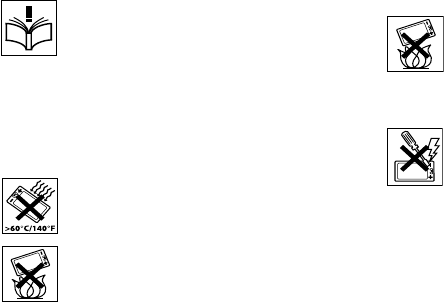
This is the Internet version of the user's guide. © Print only for private use.
Additional information 61
Guidelines for Safe and Efficient Use
Please read this information before using
your mobile phone.
RECOMMENDATIONS
• Always treat your product with care and keep it in a clean
and dust-free place.
• Do not expose your product to liquid or moisture or
humidity.
• Do not expose your product to extreme high
or low temperatures.
• Do not expose your product to open flames
or lit tobacco products.
• Do not drop, throw or try to bend your
product.
• Do not paint your product.
• Do not use your product near medical equipment without
requesting permission.
• Do not use your product when in, or around aircraft, or
areas posted “turn off two-way radio”.
• Do not use your product in an area where a
potentially explosive atmosphere exists.
• Do not place your product or install wireless
equipment in the area above your car’s air
bag.
• Do not attempt to disassemble your
product. Only Sony Ericsson authorized
personnel should perform service.
• Do not direct the infrared ray at anyone's
eye and make sure that it does not disturb
any other infrared units.
• To avoid hearing impairment, accept the call before
holding your product (or portable handsfree device) to
your ear.
ANTENNA
Only use an antenna that has been specifically designed
by Sony Ericsson for your mobile phone. Use of
unauthorised or modified antennas could damage your
mobile phone and may violate regulations, causing loss
of performance and SAR levels above the recommended
limits (see below).
This is the Internet version of the user's guide. © Print only for private use.
62 Additional information
EFFICIENT USE
Hold your mobile phone as you would any other phone.
Do not cover the top of the phone when in use, as this
affects call quality and may cause the phone to operate
at a higher power level than needed, thus shortening talk
and standby times.
RADIO FREQUENCY (RF) EXPOSURE
AND SAR
Your mobile phone is a low-power radio transmitter
and receiver. When it is turned on, it emits low levels of
radio frequency energy (also known as radio waves or
radio frequency fields).
Governments around the world have adopted
comprehensive international safety guidelines,
developed by scientific organizations, e.g. ICNIRP
(International Commission on Non-Ionizing Radiation
Protection) and IEEE (The Institute of Electrical and
Electronics Engineers Inc.), through periodic and
thorough evaluation of scientific studies. These
guidelines establish permitted levels of radio wave
exposure for the general population. The levels include a
safety margin designed to assure the safety of all
persons, regardless of age and health, and to account for
any variations in measurements.
Specific Absorption Rate (SAR) is the unit of
measurement for the amount of radio frequency energy
absorbed by the body when using a mobile phone. The
SAR value is determined at the highest certified power
level in laboratory conditions, but the actual SAR level of
the mobile phone while operating can be well below this
value. This is because the mobile phone is designed to
use the minimum power required to reach the network.
Therefore, the closer you are to a base station, the more
likely it is that the actual SAR level will decrease.
Variations in SAR below the radio frequency exposure
guidelines do not mean that there are variations in safety.
While there may be differences in SAR levels among
mobile phones, all Sony Ericsson mobile phone models
are designed to meet radio frequency exposure
guidelines.
Accessories can significantly affect a mobile phone's
compliance with the radio frequency exposure
guidelines. For example, the Federal Communication
Commission in the U.S. requires that some
manufacturers' accessories shall be tested, and Sony
Ericsson has done so with respect to its products. To
avoid causing loss of performance or radio frequency
exposure levels above the permissible limits it is
recommended that you only use Sony Ericsson or
Ericsson original accessories intended for use with the
mobile phone. If you wear the mobile phone on your
body while it is transmitting, and you do not use a Sony
Ericsson or Ericsson original body worn accessory,
please ensure that the mobile phone is positioned a
minimum of 1.5 cm from your body and that you are not
using an accessory that contain any metal.

This is the Internet version of the user's guide. © Print only for private use.
Additional information 63
A separate leaflet with SAR information for this mobile
phone model is included with the material that comes
with this mobile phone. This information can also be
found, together with more information on radio frequency
exposure and SAR, on: www.sonyericsson.com.
DRIVING
Please check if local laws and regulations restrict the use
of mobile phones while driving or require drivers to use
handsfree solutions. We recommend that you use only
Ericsson or Sony Ericsson handsfree solutions intended
for use with your product. Please note that because of
possible interference to electronic equipment, some
vehicle manufacturers forbid the use of mobile phones in
their vehicles unless a handsfree kit with an external
antenna supports the installation.
Always give full attention to driving and pull off the
road and park before making or answering a call if driving
conditions so require.
PERSONAL MEDICAL DEVICES
Mobile phones may affect the operation of cardiac
pacemakers and other implanted equipment. Please
avoid placing the mobile phone over the pacemaker, e.g.
in your breast pocket. When using the mobile phone,
place it at the ear opposite the pacemaker. If a minimum
distance of 15 cm (6 inches) is kept between the mobile
phone and the pacemaker, the risk of interference is
limited. If you have any reason to suspect that
interference is taking place, immediately turn off your
mobile phone. Contact your cardiologist for more
information.
For other medical devices, please consult the
manufacturer of the device.
CHILDREN
DO NOT ALLOW CHILDREN TO PLAY
WITH YOUR MOBILE PHONE OR ITS
ACCESSORIES. THEY COULD HURT
THEMSELVES OR OTHERS, OR COULD
ACCIDENTALLY DAMAGE THE MOBILE PHONE OR
ACCESSORY. YOUR MOBILE PHONE OR ITS
ACCESSORY MAY CONTAIN SMALL PARTS THAT
COULD BE DETACHED AND CREATE A CHOKING
HAZARD.
DISPOSING OF THE PRODUCT
Your mobile phone should not be placed in
municipal waste. Please check local
regulations for disposal of electronic
products.
POWER SUPPLY
Connect the AC power adapter only to designated power
sources as marked on the product. Make sure the cord is
positioned so that it will not be subjected to damage or
stress. To reduce risk of electric shock, unplug the unit
from any power source before attempting to clean it. The

This is the Internet version of the user's guide. © Print only for private use.
64 Additional information
AC power adapter must not be used outdoors or in damp
areas. Never alter the cord or plug. If the plug will not fit
into the outlet, have a proper outlet installed by a
qualified electrician.
EMERGENCY CALLS
Mobile phones operate using radio signals, which cannot
guarantee connection under all conditions. Therefore you
should never rely solely upon any mobile phone for
essential communications (e.g. medical emergencies).
Emergency calls may not be possible on all cellular
networks or when certain network services and/or mobile
phone features are in use. Check with your local service
provider.
Emergency Response Center Location Technology
Using wireless technology to help find you in case of an
emergency is a goal shared by the entire wireless
industry, local phone companies and the emergency
response centers. Your phone may support an
emergency positioning system being implemented by
some service providers. But the complexity of mobile
communication technology, combined with related
implementation technologies, means that your wireless
carrier, the local phone companies, and emergency
response centers all have a role to play in implementing
this capability.
So even if your phone supports this technology and
even if the locating features works in one area there is no
guarantee that it will work in all areas for all calls to
emergency response centers. Always review with an
emergency response center all location data you have,
including intersecting streets, as well as any landmarks,
to assist in locating you.
Sony Ericsson is committed to continuing to work with
the entire communications industry to improve location
features for emergency response.
Sony Ericsson is not liable for any service(s)
including operation, coverage, or range of the network
services provided by network carriers independent of
Sony Ericsson.
BATTERY USE AND CARE
We recommend that you fully charge the battery
before you use your mobile phone for the first time.
The battery can only be charged in temperatures
between +5°C (+41°F) and +45°C (+113°F).
A new battery or one that has not been used for a
long time could have reduced capacity the first few times
it is used.
The talk and standby times depend on the actual
transmission conditions when using the mobile phone. If
the mobile phone is used near a base station, less power
is required and talk and standby times are prolonged.
•Warning! May explode if disposed of in fire.
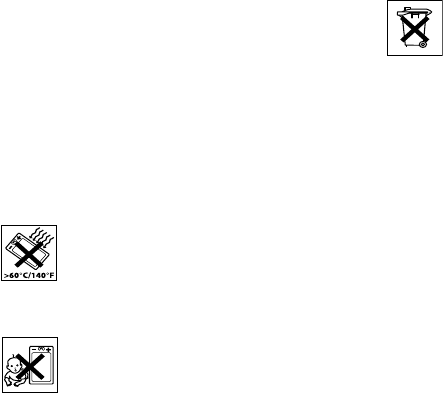
This is the Internet version of the user's guide. © Print only for private use.
Additional information 65
• Use only Ericsson or Sony Ericsson branded original
batteries and chargers intended for use with your mobile
phone. Other chargers may not charge sufficiently or
may produce excessive heat. Using other batteries and
chargers could be dangerous.
• Do not expose the battery to liquid.
• Do not let the metal contacts on the battery touch another
metal object. This could short-circuit and damage the
battery.
• Do not disassemble or modify the battery.
• Do not expose the battery to extreme
temperatures, never above +60°C (+140°F).
For maximum battery capacity, use the
battery at room temperature.
• Turn off your mobile phone before removing the battery.
• Keep out of children’s reach.
• Use the battery for the intended purpose
only.
• Do not allow the battery to be put into the mouth. Battery
electrolytes may be toxic if swallowed.
DISPOSING OF THE BATTERY
Please check local regulations for disposal
of batteries or call your local Sony Ericsson
Customer Care Center for information.
The battery should never be placed in
municipal waste. Use a battery disposal
facility if available.
Limited Warranty
Sony Ericsson Mobile Communications AB, S-221 88
Lund, Sweden, (Sony Ericsson), provides this Limited
Warranty for your mobile phone and original accessory
delivered with your mobile phone (hereinafter referred to
as “Product”).
Should your Product need warranty service, please
return it to the dealer from whom it was purchased, or
contact your local Sony Ericsson Customer Care Centre
(national rates may apply) or visit
www.SonyEricsson.com to get further information.
OUR WARRANTY
Subject to the conditions of this Limited Warranty, Sony
Ericsson warrants this Product to be free from defects in
design, material and workmanship at the time of its
original purchase by a consumer, and for a subsequent
period of one (1) year.
This is the Internet version of the user's guide. © Print only for private use.
66 Additional information
WHAT WE WILL DO
If, during the warranty period, this Product fails to
operate under normal use and service, due to defects in
design, materials or workmanship, Sony Ericsson
authorized distributors or service partners, in the country/
region* where you purchased the Product, will, at their
option, either repair or replace the Product in accordance
with the terms and conditions stipulated herein.
Sony Ericsson and its service partners reserve the
right to charge a handling fee if a returned Product is
found not to be under warranty according to the
conditions below.
Please note that your personal settings/downloads
might be lost when the Product is repaired or replaced.
CONDITIONS
1. The warranty is valid only if the original proof of purchase
issued to the original purchaser by an, for this Product,
Sony Ericsson authorized dealer, specifying the date of
purchase and serial number**, is presented with the
Product to be repaired or replaced. Sony Ericsson
reserves the right to refuse warranty service if this
information has been removed or changed after the
original purchase of the Product from the dealer.
2. If Sony Ericsson repairs or replaces the Product, the
repaired or replaced Product shall be warranted for the
remaining time of the original warranty period or for
ninety (90) days from the date of repair, whichever is
longer. Repair or replacement may involve the use of
functionally equivalent reconditioned units. Replaced
parts or components will become the property of Sony
Ericsson.
3. This warranty does not cover any failure of the Product
due to normal wear and tear, or due to misuse, including
but not limited to use in other than the normal and
customary manner, in accordance with the Sony
Ericsson instructions for use and maintenance of the
Product. Nor does this warranty cover any failure of the
Product due to accident, software or hardware
modification or adjustment, acts of God or damage
resulting from liquid.
4. Since the cellular system on which the Product is to
operate is provided by a carrier independent from Sony
Ericsson, Sony Ericsson will not be responsible for the
operation, availability, coverage, services or range of that
system.
5. This warranty does not cover Product failures caused by
installations, modifications, or repair or opening of the
Product performed by a non-Sony Ericsson authorized
person.
6. The warranty does not cover Product failures which have
been caused by use of accessories or other peripheral
devices which are not Ericsson or Sony Ericsson

This is the Internet version of the user's guide. © Print only for private use.
Additional information 67
branded original accessories intended for use with the
Product.
7. Tampering with any of the seals on the Product will void
the warranty.
8. THERE ARE NO EXPRESS WARRANTIES, WHETHER
WRITTEN OR ORAL, OTHER THAN THIS PRINTED
LIMITED WARRANTY. ALL IMPLIED WARRANTIES,
INCLUDING WITHOUT LIMITATION THE IMPLIED
WARRANTIES OF MERCHANTABILITY OR FITNESS
FOR A PARTICULAR PURPOSE, ARE LIMITED TO
THE DURATION OF THIS LIMITED WARRANTY. IN NO
EVENT SHALL SONY ERICSSON OR ITS LICENSORS
BE LIABLE FOR INCIDENTAL OR CONSEQUENTIAL
DAMAGES OF ANY NATURE WHATSOEVER,
INCLUDING BUT NOT LIMITED TO LOST PROFITS OR
COMMERCIAL LOSS, TO THE FULL EXTENT THOSE
DAMAGES CAN BE DISCLAIMED BY LAW.
Some countries/states do not allow the exclusion or
limitation of incidental or consequential damages, or
limitation of the duration of implied warranties, so the
preceding limitations or exclusions may not apply to you.
The warranty provided does not affect the consumer's
statutory rights under applicable legislation in force, nor
the consumer's rights against the dealer arising from
their sales/purchase contract.
* EUROPEAN UNION (EU)
If you have purchased your Product in an EU country you
can have your Product serviced, under the conditions set
out above, within the warranty period in any EU country
where an identical Product is sold by an authorized Sony
Ericsson distributor. To find out if your Product is sold in
the EU country you are in, please call the local Sony
Ericsson Customer Care Centre. Please observe that
certain services may not be possible elsewhere than in
the country of original purchase, for example, due to the
fact that your Product may have an interior or exterior
which is different from equivalent models sold in other
EU countries. It may not be possible to repair SIM-locked
Products.
** In some countries/regions additional information is
requested. If so, this is clearly shown on the valid proof of
purchase.
FCC Statement
This device complies with Part 15 of the
FCC rules. Operation is subject to the
following two conditions:
(1) This device may not cause harmful interference, and
(2) This device must accept any interference received,
including interference that may cause undesired
operation.

This is the Internet version of the user's guide. © Print only for private use.
68 Additional information
Before a phone model is available for sale to the
public, it must be tested and certified to the FCC that it
does not exceed the limit established by the government-
adopted requirement for safe exposure. The tests are
performed in positions and locations (that is, at the ear
and worn on the body) as required by the FCC for each
model. Body worn measurements are made while the
phone is in use and worn on the body with, if available,
an Ericsson or Sony Ericsson branded original accessory
intended for use with the phone. The design and
composition of an accessory can affect the body worn
SAR (Specific Absorption Rate) levels for the phone.
Sony Ericsson has not measured, and makes no
representation about, the body worn SAR levels when
the phone is used with non-Ericsson or non-Sony
Ericsson branded original accessories intended for use
with the phone.
For Canadian Customers
The term "IC:" before the radio certification number only
signifies that industry Canada technical specifications
were met.
Declaration of Conformity
We, Sony Ericsson Mobile Communications AB of
Nya Vattentornet
S-221 88 Lund, Sweden.
declare under our sole responsibility that our product
Sony Ericsson type 113 0602-BV
and in combination with our accessories, to which this
declaration relates is in conformity with the appropriate
standards 3GPP TS 51.010-1, EN 301489-7, EN 60950,
following the provisions of, Radio Equipment and
Telecommunication Terminal Equipment directive
99/5/EC with requirements covering EMC directive
89/336/EEC, and Low Voltage directive 73/23/EEC.
We fulfill the requirements of the R&TTE Directive
(99/5/EC).
Lund, December 2002
Place & date of issue 0682
Kentaro Odaka, Head of Product Business Unit GSM/UMTS
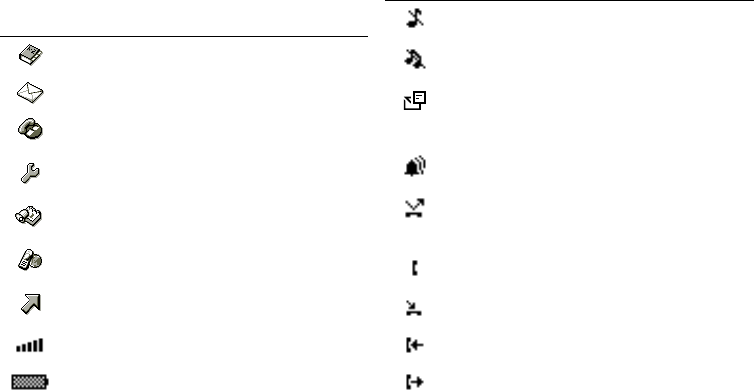
This is the Internet version of the user's guide. © Print only for private use.
Display icons 69
Display icons
Symbol Description
Your personal phone book.
Handling of text and voice messages.
Handling of call time, call cost information
and ongoing calls.
Personal settings, profiles, forwarding calls
and networks.
Calendar, pictures, alarm clock and other
extras.
Gives you access to WAP services on the
Internet.
Create your own menu for the functions you
use most often.
Network signal indicator.
Battery status indicator.
The ring signal is turned off.
All audible signals are turned off, except the
alarm and timer.
You have received a text message. If the icon
is flashing, you have to empty the inbox in
order to receive the text message.
The alarm clock has been set and is on.
All incoming calls will be forwarded to a
defined number, or Restrict Calls is in
operation.
You have an ongoing call.
Indicates a missed call in the call list.
Indicates an answered call in the call list.
Indicates a dialed number in the call list.
Symbol Description
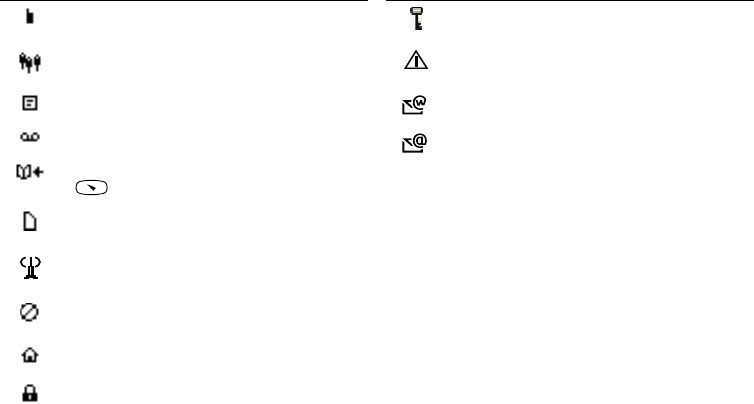
This is the Internet version of the user's guide. © Print only for private use.
70 Display icons
The phone book entry is saved in the phone
memory.
The phone book entry is a group.
Unread text message.
Unchecked voice message.
You can enter the phone book by pressing
.
The text message is saved in the SIM card
memory.
The network is preferred and can be used.
Forbidden network.
Your home network is within range.
The card lock or phone lock is on.
Symbol Description
The keypad is locked.
Encrypting is currently not being provided by
the network.
You have received a WAP push message.
You have received an e-mail message.
Symbol Description
This is the Internet version of the user's guide. © Print only for private use.
Index 71
Index
A
Accept calls 42
Alarm clock 53
set time 53
turn off 54
Alarm indicator 69
Alarm signal 54
Answering a call 28
Answering mode 23
Answering service. See Voice mail
service
Area information 47
receiving area messages 47
Ask to save 32
Assembling the phone 8
B
Barring calls. See Restrict calls
Battery indicator 69
C
Calendar 52
Call barring. See Restrict calls
Call cost 36
setting a credit limit 36
setting a price per call unit 36
Call divert
divert indicator 69
Call forwarding
turn off 37
Call forwarding turn on 37
Call forwarding. See Call divert
Call list 30
call number 30
Call restrictions. See Restrict calls
Call time 36
Call waiting service 38
turn off 38
turn on 38
Caller Identification service 28
Calls
answering 28
conference 39
emergency 28
ending 27
hiding your number 29
international 27
making 27
putting on hold 38, 39
receiving 28
rejecting 28
showing your number 29
switching between calls 38
Cell information 48
Clock. See Time
Closed user groups 41
Conference calls 39
adding a participant 39
extracting a participant 39
releasing a participant 40
releasing all participants 40
setting up 39
D
Date 23
setting 23
Declaration of conformity 68
Display
light 20
start-up/shut-down show 23
Display colour 20
Divert indicator 69
This is the Internet version of the user's guide. © Print only for private use.
72 Index
E
Earpiece volume 27
Emergency calls 28
Emergency numbers 28
Ending a call 27
F
Fixed dialing 40
Fixed dialling
turn on 41
Fixed numbers 41
storing 41
Forward calls
turn off 37
Forwarding calls. See Call divert
Foward calls
turn on 37
G
Groups. See Phone book
H
Handsfree 23
Hiding your number 29
I
Int. emergency number 28
International calls 27
K
Key functions 11, 12
quick keys 5
Key sound 20
Keypad 7
Keypad lock 24
automatic 24
manual 24
unlock 24
L
Letters
entering 15
M
Making a call 27
Master reset 26
Menus
display text 13
leave a menu 12
moving (scroll) through 12
select a menu 12
Message signal 20
Messages. See Text messages
Microphone
muting 27
turning off 27
Minute minder 20
Mobile Internet 48
locks 51
security 50
Muting the microphone 27
My shortcuts 25
add function 25
remove function 25
N
Network 42
selecting 42
Notepad 29
P
Personal ring signal 19
Phone book 30
ask to save 32
calling from 31
card memory 33
checking the memory 34
delete a phone number 33
This is the Internet version of the user's guide. © Print only for private use.
Index 73
edit a name 32
edit a phone number 32
groups 34
memory 33
overwrite protection 34
phone memory 33
save a number 31
shortcuts 32
sort order 33
Phone lock
activating/cancelling 57
auto lock 56
changing the security code 56
on 56
Pictures 20
PIN
changing 56
PIN2
changing 56
Plus sign (+) 27
Profiles
selecting 25
PUK 55
Q
Quick keys 5
R
Reading a message 45
Receiving a call 28
Redialing
automatic 27
Rejecting a call 28
Restrict calls 40
changing password 40
changing status 40
Ring signal
choosing 18
compose own melody 19
increasing ring 18
message signal 20
personal 19
turn off 18
volume 20
S
Save a number 31
Send a message 43
Service center 43
Showing your number 29
Silent ring signal 18
SIM card
copy contacts 34
unblocking 55
SIM card lock
activating/cancelling 56
SMS. See Text messages
Sony Ericsson Mobile Internet 22
Sony Ericsson web site 60
Stopwatch 54
Switching between two calls 38
T
T9 Text Input 16
key functions 17
Text messages
call phone number 46
deleting 46
forwarding 46
options 44
reading 45
replying 46
saving 46
sending 43
Time 22
format 22
setting the time 22
Tone signals
turn off 29